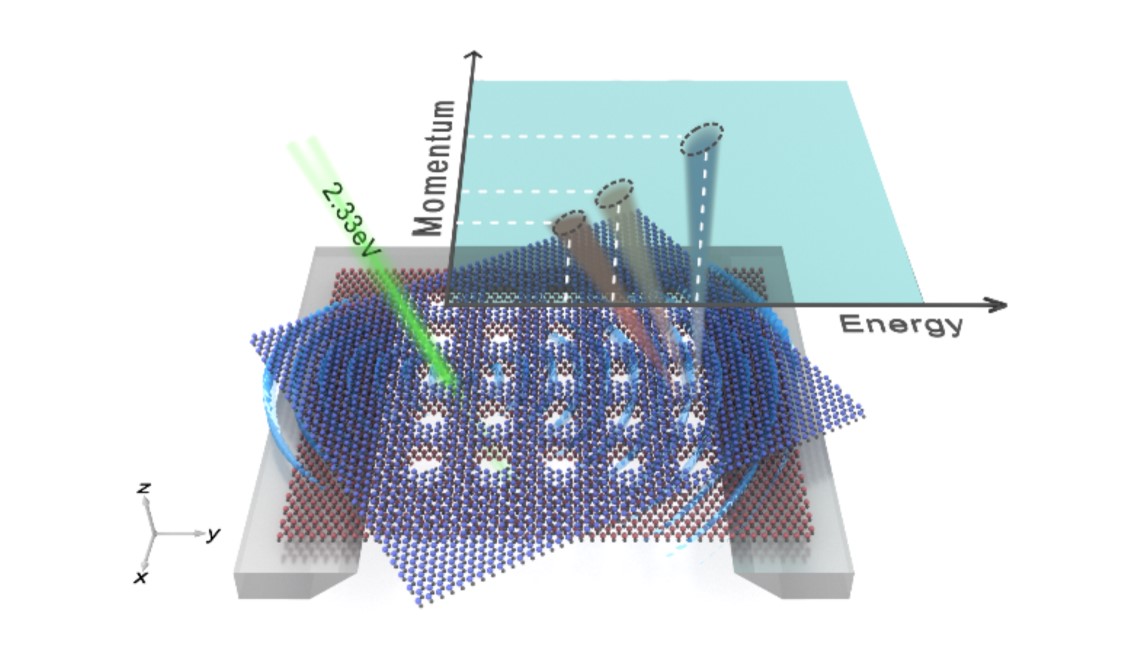Researchers from Suzhou Institute of Nanotechnology and Nanobionics (SINANO), China Academy of Sciences have pioneered a novel approach to address long-standing challenges in exciton emission control of 2D semiconductors by directly patterning photonic crystal (PhC) structures in free-standing twisted WS2/WSe2hetero-bilayers. This approach eliminates luminescence suppression effects suffered from the contact interfaces for conventional methods, opening new avenues for 2D semiconductor light-emitting devices. This work was recently published in Science Advances by Professor ZHANG Xingwang’s research group in SINANO.
Two-dimensional transition metal chalcogenides (TMDs) are regarded as promising materials for the next generation optoelectronic devices due to their atomic thickness and unique optoelectronic properties. In particular, recent advances in twisted TMDs hetero-bilayers have revealed that new exciton states arise due to the twist-angle-dependent inter-layer coupling between adjacent layers. As a result, the twisted TMDs hetero-bilayers not only have intra-layer excitons that are supported by each constituent layers, but also offer new inter-layer excitons that are highly tunable via the twist-angle.
However, owing to the lack of photonic resonances in hetero-bilayers themselves, it is inevitable to rely on external optical resonators to provide photonic resonances to manipulate the excitons emission properties, which can not only introduce n-type doping and defect-assisted nonradiative exciton recombination in hetero-bilayers from the dielectric interfaces, but also significantly reduce the binding energies of inter-layer excitons due to the increased dielectric screening effects from the contacted dielectrics.
To address these challenges, the team directly patterned PhC structures in free-standing twisted WS2/WSe2 hetero-bilayers. The PhC structures in the free-standing twisted WS2/WSe2 hetero-bilayer give rise to guided mode resonances, which can not only enhance the Purcell factors and extraction rates of excitons at the atomic thickness scale, but also enable momentum matching condition between the wave vector inside the hetero-bilayer and the free-space wave vector. As such, light emitted from excitons is coupled to the free-space with an energy-dependent position in the momentum space, which is determined by the momentum matching condition. Consequently, both intra-layer and inter-layer driven exciton emissions in the free-standing twisted WS2/WSe2 hetero-bilayer are resonantly separated in the energy-momentum space.
In addition, by adjusting the excitation laser energy, specific excitons can be selectively excited. By virtue of the dispersion properties of photonic crystals, exciton emissions can be separated in energy-momentum space. "Photonic crystals can be envisioned as a 'traffic control system' for photons, where exciton emissions act as 'photonic cars' with different colors." Prof. Zhang said. "Photonic crystals automatically guide 'photonic cars' to different ' travel directions' (momentum) according to their 'colors' (energy).

Schematic of directional sorting of exciton emissions from free-standing PhC WS2/WSe2 hetero-bilayers. (Image by Dr. CHEN Yuhua)
Contact information:
ZHANG Xingwang
Suzhou Institute of Nanotechnology and Nanobionics (SINANO), China Academy of Sciences
Email: xwzhang2021@sinano.ac.cn
Reference:
downloadFile
